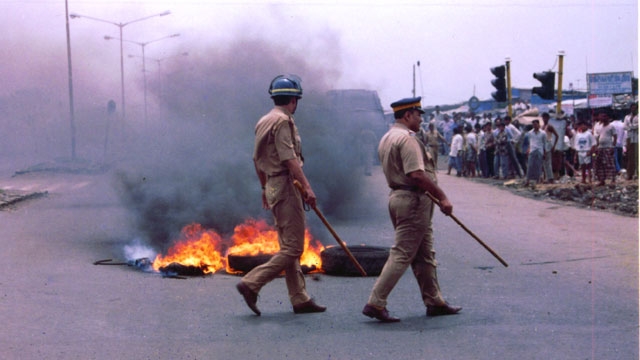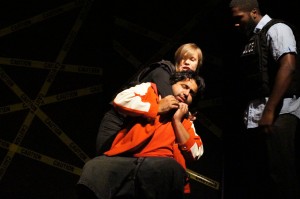
Indian police, like police everywhere, oppressing the people -- in this case, working class untouchables.
Rating: 3.5/4. Directed by Anand Patwardhan. Running time 185 minutes.
A complex musical documentary about that side of India that we don’t see in the media: oppressive, exploitative and brutal. Jai Bhim Comrade is about the “untouchable” Dalit castes of India and the music of their resistance.
The caste system means that people are born into occupation groups, some of which are considered “pure” and others “less pure” — the “least pure” of all are literally untouchables. It’s kind of like the racial system in North America, as the people at the bottom of the ladder are more likely to be poor and oppressed, and discriminated against by upper castes.
“Jai Bhim Comrade” means “Long Live Bhim, Comrade!” — “Bhim” is a nickname for Bhimrao Ambedkar, the great 20th century leader of Dalits who drafted India’s constitution and reinvented Buddhism into an anti-caste religion against superstition and ignorance.
Many Dalit activists have combined revolutionary leftist politics with anti-caste politics, and that is where the film begins, with a huge march in Mumbai (Bombay), as hundreds of Dalits/workers wave red flags and one activist in particular sings a song of freedom:
The singer poet, Vilas Ghogre, drifts away from his leftist comrades as they fail to approve of his attempts to make a livelihood for his family by singing at events for other political groups, and moreover because his comrades don’t have a proper analysis of caste. In 1997, when police shoot and kill 10 unarmed Dalit protestors in a Mumbai slum, he kills himself in protest against the hypocrisy of Indian democracy.
Over the next 15 years, Ghogre’s friend, director Anand Patwardhan, tracks the various strands of Dalit life: the way Dalit workers are discriminated against and mistreated, the way Dalit activists try to spread a consciousness-raising, anti-superstitious way of thinking, and the different political factions that take inspiration from Ambedkar. We see how Dalits and Adivasis (the so-called untouchable tribals) are treated in the most violent and brutal of ways—raped and lynched frequently.
The film also shows upper caste Indians who claim to have superior, pure blood and their depraved politics. In some cases, we see how opportunistic Dalit parties cut deals with casteist Hindu-supremacist parties to get ahead, while other Dalit activists who fight against such politics are killed and persecuted.
In all of this, director Patwardhan weaves together a complex web of in-depth stories of families and individuals, their day-to-day lives and struggles, and the broader and more general story of an India degenerating into greater inequality, deeper Hindu-supremacy, and oppressive politics in general.
But he does so with great skill, interspersing footage with the music of Dalit spirituality, politics and resistance. Nothing we write can quite capture the essence of the film — It is a long film at about three hours, but it is worth watching, processing and reflecting upon. Notably, it calls on us to take action in solidarity with those progressive forces who mix the blue of Dalit politics with the red of revolutionary leftist politics.
The film ends on a note that is both hopeful and dismaying. A troupe of performing artists raise awareness about caste, gender and class discrimination, and encourage Dalits and workers to unite and rise up. It’s kind of how the film starts:
But their message is so powerful that the Indian government declares them Maoist rebels and they flee underground to avoid persecution. Learn more about the Kabir Kala Manch and about other progressive forces in India today .
Comments

